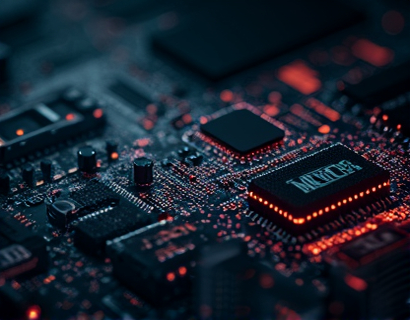Advanced Layer 2 Solutions: Revolutionizing Blockchain Scalability and Efficiency for EVM-Enabled Development
In the rapidly evolving landscape of blockchain technology, scalability and efficiency have emerged as critical challenges for developers, especially those working with Ethereum Virtual Machine (EVM)-enabled platforms. The inherent limitations of Layer 1 blockchains, such as limited transaction throughput and high gas fees, have spurred the development of advanced Layer 2 solutions. These solutions aim to enhance scalability, security, and efficiency, enabling the creation of faster, more secure, and cost-effective decentralized applications (dApps). This article delves into the transformative impact of advanced Layer 2 solutions on EVM-based blockchain development, providing insights for blockchain developers and innovators.
Understanding Layer 2 Solutions
Layer 2 solutions refer to technologies built on top of existing blockchain networks (Layer 1) to improve performance and reduce costs. Unlike Layer 1 upgrades, which involve modifying the core protocol, Layer 2 solutions operate within the existing framework, offloading some of the computational and storage tasks. This approach allows for higher transaction volumes and faster processing times without compromising the security and decentralization of the underlying blockchain.
For EVM-enabled blockchains, Layer 2 solutions are particularly crucial. The EVM, while powerful, has limitations in terms of scalability and cost efficiency. Transactions on the EVM can be slow and expensive, especially during peak times. Layer 2 solutions address these issues by processing transactions off the main chain and only settling the final state on the blockchain, thereby reducing the load on the EVM.
Key Advanced Layer 2 Solutions
Several advanced Layer 2 solutions have gained prominence in the blockchain community, each offering unique benefits and use cases. Some of the most notable solutions include state channels, sidechains, and rollups.
State Channels
State channels enable multiple parties to conduct a series of transactions off the main blockchain, with only the final state being recorded on the chain. This method significantly reduces the number of transactions that need to be processed on the EVM, leading to lower fees and faster confirmation times. State channels are particularly useful for applications requiring frequent and small transactions, such as gaming and micropayments.
One of the primary advantages of state channels is their ability to maintain privacy and reduce network congestion. However, they require all participants to be online simultaneously to finalize transactions, which can be a limitation in certain scenarios.
Sidechains
Sidechains are independent blockchains that are linked to the main blockchain, allowing assets to be transferred between the two. This setup enables sidechains to operate with different consensus mechanisms and rules, optimizing for specific use cases. Sidechains can handle higher transaction volumes and lower fees, making them suitable for high-throughput applications.
A key feature of sidechains is their ability to integrate with the main blockchain through atomic swaps or cross-chain bridges. This integration ensures that assets remain secure and interoperable, while benefiting from the efficiency of the sidechain.
Rollups
Rollups are one of the most promising Layer 2 solutions for scalability. They come in two main types: Optimistic Rollups and ZK-Rollups.
Optimistic Rollups bundle multiple transactions into a single transaction on the main chain, with a fraud proof mechanism to ensure validity. If no fraud is detected within a grace period, the transaction is confirmed. This approach significantly reduces gas fees and increases transaction speed, making it ideal for dApps with high transaction volumes.
ZK-Rollups, on the other hand, use zero-knowledge proofs to bundle and verify transactions off-chain, submitting a compact proof to the main chain. This method offers even higher scalability and faster confirmation times, though it requires more complex cryptographic techniques.
Benefits of Advanced Layer 2 Solutions
The adoption of advanced Layer 2 solutions brings numerous benefits to EVM-based blockchain development. These benefits are crucial for building faster, more secure, and cost-effective dApps.
Enhanced Scalability
One of the most significant advantages of Layer 2 solutions is their ability to handle a much higher volume of transactions per second (TPS) compared to Layer 1 blockchains. By offloading transactions to a secondary layer, these solutions alleviate the congestion on the main chain, leading to faster transaction processing and reduced wait times. This enhanced scalability is essential for dApps that require high throughput, such as decentralized finance (DeFi) platforms and gaming applications.
Reduced Costs
High gas fees on Layer 1 blockchains have been a persistent issue, making it expensive to execute transactions and smart contracts. Layer 2 solutions mitigate this problem by processing transactions off the main chain, where fees are significantly lower. This cost reduction makes blockchain technology more accessible to a broader range of developers and users, fostering greater adoption and innovation.
Improved Security
Despite the off-chain processing, advanced Layer 2 solutions maintain the security guarantees of the underlying blockchain. Techniques such as cryptographic proofs in ZK-Rollups ensure that transactions are valid and tamper-proof. State channels and sidechains also employ robust security measures to protect assets and data. The layered approach does not compromise the decentralization and security of the EVM, providing a balanced solution to scalability challenges.
Increased Efficiency
Efficiency is a critical factor for dApp developers, as it directly impacts user experience and application performance. Layer 2 solutions streamline the transaction process, reducing the computational load on the EVM. This efficiency allows developers to build more complex and feature-rich applications without worrying about scalability bottlenecks. Additionally, the reduced latency and faster confirmation times enhance the overall user experience, making dApps more competitive in the market.
Implementing Advanced Layer 2 Solutions in EVM-Based Development
For developers looking to leverage advanced Layer 2 solutions in their EVM-based projects, several steps and considerations are essential for a successful implementation.
Choosing the Right Solution
The first step is to evaluate the specific requirements of the project and choose the most suitable Layer 2 solution. Factors to consider include transaction volume, fee sensitivity, privacy needs, and the complexity of the application. For instance, state channels might be ideal for applications with frequent small transactions, while rollups could be better suited for dApps requiring high throughput and low fees.
Integration with EVM
Integrating Layer 2 solutions with EVM-based blockchains involves bridging the two layers seamlessly. This typically involves developing custom smart contracts that interact with both the main chain and the Layer 2 network. Developers need to ensure that the bridges are secure and reliable, maintaining the integrity of transactions and data across layers.
Testing and Optimization
Thorough testing is crucial to identify and resolve any issues related to the Layer 2 implementation. Developers should simulate real-world scenarios to test the performance, security, and usability of their dApps. Optimization techniques, such as batch processing and efficient state management, can further enhance the performance and cost-effectiveness of the solution.
Community and Ecosystem Support
Engaging with the broader blockchain community and leveraging existing tools and libraries can significantly ease the implementation process. Many open-source projects and frameworks are available to help developers integrate Layer 2 solutions into their EVM-based applications. Participating in community forums and contributing to the development of these tools can also provide valuable insights and support.
Future Prospects and Innovations
The landscape of Layer 2 solutions is rapidly evolving, with ongoing research and development pushing the boundaries of what is possible. Some of the exciting advancements on the horizon include:
- **Interoperability**: Enhanced cross-chain interoperability will allow Layer 2 solutions to work seamlessly across different blockchain ecosystems, expanding the reach and utility of dApps.
- **Layer 1 Integration**: Future Layer 1 blockchains may incorporate built-in Layer 2 capabilities, providing native support for scalability solutions and further improving performance.
- **Advanced Cryptography**: The development of more sophisticated cryptographic techniques will enhance the security and efficiency of Layer 2 solutions, addressing concerns related to fraud and scalability.
- **User-Friendly Tools**: The creation of more intuitive development tools and platforms will lower the barrier to entry for developers, making it easier to implement and manage Layer 2 solutions.
These innovations promise to make Layer 2 solutions even more powerful and accessible, driving the next wave of blockchain innovation and adoption.
Conclusion
Advanced Layer 2 solutions are revolutionizing blockchain scalability and efficiency, particularly for EVM-based development. By offloading transactions to secondary layers, these solutions address the limitations of Layer 1 blockchains, enabling the creation of faster, more secure, and cost-effective dApps. As the technology continues to evolve, developers and innovators have the opportunity to build more sophisticated and user-friendly blockchain applications, shaping the future of decentralized technologies.










































